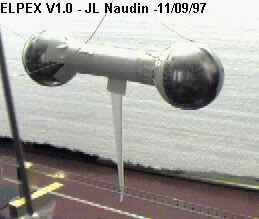

The Electrostatic Pendulum Experiment from P. Cornille
The ELPEX Project - Questions and Answers
created on 11/16/97 - JLN Labs - last update on 02/12/99
I will answer below the most frequently asked questions. First, let me give you more details about the experiments. The balls are massive aluminum balls weighting 500 g each. We also use professional high voltage power supplies bought from Glassman where the currents and the voltages are measured at all times with a good accuracy. The pendulum was placed in the middle of the laboratory at a distance greater than 2.2 m from the insulating walls.
First question:
is the stimulated force produced by the electrostatic forces
resulting from the induced charges in the surroundings ?
Four tests were done to reject the hypothesis that the force is
induced by the surroundings:
First test, we switch the polarity of the power supplies and
observe that the direction of the force has also changed 180°.
We recall that the direction of the force must not change if the
stimulated force is produced by asymmetries of the electrostatic
forces.
Second test, we put a wood plate about 5 mm near by the negative
ball. When the voltage is increased, one can see the pendulum
attracted by the induced charges in the wood plate, at about 30
kV when we increase the voltage above this value, then the
stimulated force takes over and one can see the pendulum moving
away from the wood plate in the opposite direction.
Third test, we used coated wires to supply the balls, therefore
the ionization current almost drops to zero, about 3 micro-amp.
In that case, no more translation effect was observed even by
oscillating the D. C. voltage.
Four test, when the ionization current is present, we oscillate
the D. C. voltage and obtain an huge increase of the kinetic
energy of the pendulum which proves that we are using an external
force to produce work. We recall that an internal force can be
distinguished from an external force by oscillating the potential
function since for an internal force, the oscillating kinetic
energy does not increase with respect to time (Think of the case
of the harmonic oscillator) while for an external force the
kinetic energy does increase (Think of the case of a swing pushed
by an external observer)
The earth magnetic force play no role in this experiment since
the force involved is too small and not in the good direction.
Second question:
is the stimulated force produced by electrical wind or corona
discharge ?
We must point out that the stimulated force does not exist if
there is no current circulating inside the conductors as proved
by my formula 11. Let us recall that a current flows inside a
conductor if there is a permanent non uniform electrical field
inside the conductor. There are several ways to produce this non
uniform field, for example it can be produced by the presence of
thin wires near by the balls as explained in the paragraph 6-11
high-voltage breakdown in the Feynman lecture book, see also the
very important and not well-known paper by H. A. Pohl, Non
uniform electric fields, Scientific American, N° 12, p. 107,
(1960) dealing on this subject.
The current can also be produced by ionization of the air or by
the leakage current in a dielectric. In the report by R. L.
Talley, Twenty first century propulsion concept, N°
PL-TR-91-3009, May (1991) by Veritay Technology, Inc. where the
pendulum was in vacuum, no effect was observed because there is
no current involved in the experiment excepted in one experiment
where a dielectric was placed between the two electrodes. In that
case, the observed effect can be explained by the leakage current
in the dielectric. I think that this positive result justifies
our view point that a current is needed in order to produce a
stimulated force through the violation of Newton's third
principle. One can also criticise the experiment by noting that
the voltage 19 kV is too small to show the effect. T. T. Brown
used voltage up to 150 kV and obtained huge forces, see the book
by P. A. LaViolette, Subquantum Kinetics The Alchemy of Creation,
Publisher 1176 Hedgewood Lane, Schenectady, NY 12309, ISBN
0-9642025-0-6, (1994).
There are several possible mechanisms to explain the motion of
the pendulum by an electrical wind effect:
The first one, the thrust results from the ejection of charged
particles by the wires. Due to the cylindrical symmetry of the
wires, the reaction forces must cancel to zero on the average.
The second one, electrons are attracted by the positive ball and
the positive ions by the negative ball, due to the difference of
mass of the two species of particles, the motion should be in the
direction of the negative ball and cannot explain the thrust in
the positive direction.
The third one, both negative and positive ions are attracted by
the balls of opposite polarity. The transfer of momentum in the
positive direction can be explained by a collision process and is
due to the difference of mass between the two kind of ions.
Therefore, a calculation taking into account the mass of the
electrons shows that this transfer is quite small in comparison
with the stimulated force.
See also the :
 The Cornille's Electrostatic pendulum
Demystified ( April 13, 2002 )
The Cornille's Electrostatic pendulum
Demystified ( April 13, 2002 )Back to the Electrostatic Pendulum home page